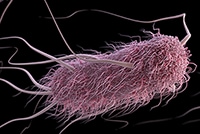FoodNet 2019 Preliminary Data
Documenting the major sources of and trends in foodborne illness provides important information needed to determine whether prevention measures are working. Each year, FoodNet reports on the number of infections in the FoodNet surveillance area from pathogens transmitted commonly through food. Laboratory tests, including cultures and culture-independent diagnostic tests (CIDTs), detected these pathogens.
This year’s report summarizes 2019 preliminary surveillance data and describes 2019 incidence compared with 2016–2018 for infections caused by Campylobacter, Cyclospora, Listeria, Salmonella, Shiga toxin-producing Escherichia coli (STEC), Shigella, Vibrio, and Yersinia. The report also summarizes cases of hemolytic uremic syndrome (HUS) in 2018.
Key Findings from 2019 Surveillance Data
- FoodNet surveillance data indicate that progress in controlling major foodborne pathogens in the United States has stalled.
- Salmonella serotypes vary in incidence.
- Enteritidis has been the most common cause of Salmonella infections since 2007 and incidence has not decreased.
- Infantis infections are increasing and many are now caused by a new, highly resistant strain that is found in chicken.
- Typhimurium infections are decreasing, which might be related to the widespread practice of vaccinating chickens against it.
- STEC O157 appears to be decreasing, but outbreaks linked to leafy greens continue. Non-O157 infections have increased.
- Cyclospora infections have increased. This might be partly due to increased detection (by more labs using the new tests), but people might also have increased exposure to this pathogen.
- The number of infections diagnosed by CIDTs increased 32% compared with the previous 3 years.
- Culture was attempted on 75% of all specimens with a positive CIDT
- Culture provides isolates needed for whole genome sequencing, which can provide detailed information to
- detect outbreaks,
- determine resistance patterns, and
- investigate emerging, recurring, and persistent strains.
Interpreting Changes in Incidence of Infections
What explains the increase in infections overall?
Several factors are likely responsible, including:
- More sick people might be tested because CIDTs are fast and easy to use
- More sick people might be tested when an outbreak is in the news
- More infections might be diagnosed because more laboratories are using CIDTs
- Infection rates for some pathogens are likely higher than previously known because of limited testing in the past
- People might be having more exposure to some pathogens, such as through eating fruits and vegetables raw
Reducing foodborne illness will require more widespread implementation of known prevention measures and of strategies that target particular pathogens and serotypes.
See steps you can take at home to stay safe from foodborne illness >
Why do STEC infections appear to be increasing?
In 2019, the incidence of STEC infections increased 34% compared with 2016–2018. The increased incidence was driven by an increase in the number of non-O157 STEC infections diagnosed, probably related to increased use of CIDTs.
STEC are classified by serogroup; the most common is O157. Clinical laboratories have been able to test stool samples for O157 for decades. With the increasing use of CIDTs, clinical laboratories now commonly determine if a specimen contains a Shiga toxin, and then test the specimen for O157. If they do not find O157, they assume a non-O157 STEC is present. They can then send the specimen to their state public health laboratory to determine which non-O157 STEC serogroup is present.
What can be done to reduce the incidence of Salmonella infections?
Many different serotypes (types) of Salmonella bacteria exist, and their sources vary. Therefore, addressing infections caused by Salmonella requires a multi-faceted approach that targets overall Salmonella and specific serotypes.
Chicken is an important source of Salmonella infections. Because Typhimurium infections declined after widespread vaccination of chickens against this serotype, some investigators think targeting other serotypes through poultry vaccination could be a way to reduce human illnesses. Produce is also an important source, so continued implementation of FDA’s Produce Safety Rule is important.
Questions and Answers About CIDTs
CIDTs detect the presence of a specific antigen or genetic sequence of an organism, such as Salmonella. These tests do not require laboratories to grow living organisms (a process known as culturing). Therefore, CIDTs can yield results much quicker than cultures.
Because CIDTs are fast and easy to use, they detect some illnesses that would have otherwise been missed. However, CIDTs do not provide certain information needed to characterize organisms. For example, CIDTs currently can detect Salmonella, but cannot identify the Salmonella serotype that caused the infection.
To counter these limitations, laboratories can culture specimens after a CIDT is positive (a practice called reflex culturing). In the future, we expect that CIDTs will be created that can provide information now available only from cultured specimens.
Each year, FoodNet publishes a summary of surveillance data and trends information in CDC’s Morbidity and Mortality Weekly Report (MMWR). Recent changes in diagnostic practices challenge our ability to monitor disease trends. Because CIDTs are increasingly used for diagnosis and positive results likely indicate true infections, FoodNet includes CIDT-positive results in counts of numbers of infections. FoodNet collects data to help understand how CIDTs have affected surveillance. For example, FoodNet is collecting data on the changes in number of people tested by CIDTs and laboratories using CIDTs. FoodNet is also developing analytic techniques to better assess trends in infections.
Questions and Answers About Food Safety
Since 1996, FoodNet has been counting cases and tracking trends for infections transmitted commonly through food. Information gathered on which illnesses are decreasing and which are increasing provides a foundation for food safety policy and prevention efforts. FoodNet’s surveillance data, such as those in this report, show where efforts are needed to reduce foodborne illnesses. Learn more about FoodNet >
CDC uses the best scientific methods and information available to monitor, investigate, control, and prevent foodborne illness. Using epidemiology and laboratory science, CDC assesses public health threats. CDC works closely with state health departments to monitor the frequency of specific diseases and to conduct national surveillance for the diseases it monitors.
When food safety threats appear, CDC collaborates with public health partners, including state health departments, the U.S. Food and Drug Administration (FDA), and the U.S. Department of Agriculture (USDA), to conduct epidemiologic and laboratory investigations to determine the causes of these threats and how they can be controlled. Although CDC does not regulate the safety of food, CDC works with regulatory agencies to develop robust food safety policies and assess the effectiveness of current prevention efforts. CDC provides independent scientific assessment of what the problems are, how they can be controlled, and where the gaps exist in our knowledge. You can find more information on foodborne illness and CDC’s prevention activities on CDC’s Food Safety website.
Government regulation related to food safety is the responsibility of FDA, USDA’s Food Safety and Inspection Service (USDA-FSIS), the National Marine Fisheries Service, and other regulatory agencies.
Recent regulatory efforts include the following:
- FDA is continuing to implement the FDA Food Safety Modernization Act, which establishes science and risk-based standards for the production and transportation of human and animal food, outlining specific actions that industry must take at different points of the supply chain to prevent contamination.
- FDA began inspecting large produce farms in spring 2019, and small farms, other than sprout operations, in January 2020.
- FDA expanded surveillance sampling of foreign and domestically grown produce, including romaine lettuce, fresh herbs (cilantro, basil, & parsley), processed avocado and guacamole, and cucumbers.
- FDA released a 2020 Leafy Greens STEC Action Plan in response to recurring outbreaks.
- FDA developed methods to test for Cyclospora cayetanensis in produce and water.
- FDA embarked on an initiative called the New Era of Smarter Food Safety to leverage new technologies and approaches to create a more digital, transparent, and safer food system.
- USDA-FSIS modernized poultry and swine inspection to focus FSIS inspection activities on those that are more effective in ensuring food safety.
- USDA-FSIS routinely collects and tests samples from establishments that produce chicken and turkey products to assess whether they are meeting Salmonella performance standards.
- Each month, USDA-FSIS posts the aggregate sampling results for the prior 12 months. For example, during the 12 months ending February 29, 2020, 11% of establishments processing chicken parts did not meet the performance standard (i.e., exceeded the allowable percentage positive).
- Although products from establishments that fail to meet the standards are still sold, USDA-FSIS takes actions to encourage better performance.
- USDA-FSIS makes the names of establishments and whether they did or did not meet the standards available online so buyers and consumers can make informed decisions about purchases, creating an incentive for establishments to meet standards.
- USDA-FSIS is developing new performance standards for Salmonella contamination of raw pork products.
- USDA-FSIS intends to update performance standards for Campylobacter contamination of raw poultry products, including chicken carcasses and parts.
- USDA-FSIS issued draft Salmonella performance standards for raw ground beef and beef manufacturing trimmings, a component of ground beef, with the intention of releasing final standards in the near future.
CDC works closely with regulatory agencies as they, along with industry, develop and implement measures to make our food safer.
Following four steps simple food safety steps – clean, separate, cook, and chill – can help protect you and your loved ones.
- Clean
Wash your hands and work surfaces before, during, and after preparing food. Germs can survive in many places around your kitchen, including on your hands, utensils, cutting boards, and countertops. - Separate
Separate raw meat, poultry, seafood, and eggs from ready-to-eat foods. Use separate cutting boards and keep raw meat away from other foods in your shopping cart and refrigerator. - Cook
Cook food to the right internal temperature to kill harmful bacteria. Use a food thermometer. - Chill
Keep your refrigerator below 40°F. Refrigerate leftovers within 2 hours of cooking (or within 1 hour if food is exposed to a temperature above 90°F, like in a hot car).
Find out steps you can take to prevent infection from the following pathogens:
Suggested citation: Centers for Disease Control and Prevention (CDC). Preliminary Incidence and Trends of Infections with Pathogens Transmitted Commonly Through Food — Foodborne Diseases Active Surveillance Network, 10 U.S. Sites, 2016–2019. MMWR Morb Mortal Wkly Rep. 2020 April 30.


